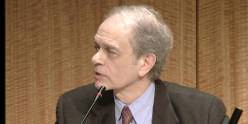WASHINGTON — The news around tuberculosis in the world generally is awful. There are an estimated 1.4 million deaths and 9 million cases a year, and the number of people with multi-drug resistant TB is going up, estimated at 650,000.
Dr. Anthony S. Fauci, the director of the National Institute of Allergy and Infectious Diseases, underscored the gloominess at the beginning of a speech yesterday on the “state of TB research,” saying that standard diagnostic tools were “embarrassing,” the understanding of how TB develops in a person is “almost non-existent,” and the drugs used to treat TB are “complex and lengthy.”
And yet, Fauci and other experts gathered at an event sponsored by the Critical Path to TB Drug Regimens at the Kaiser Family Foundation in Washington said they also foresee many positive developments ahead in the efforts to fight TB.
One was TB Alliance’s launch Monday of a clinical trial to test two novel drug candidates in combination with a third drug on the market. The results from the Phase 2, eight-week, eight-country trial won’t be known for a year, but TB Alliance leaders said an earlier trial that tested drugs in combination showed enough success to warrant this new study.
Other areas of promise were the ability to test TB drugs with the extensive HIV/AIDS trial network, which opens the door for new studies, and suddenly crowded pipelines of possible new drugs for TB.
Even Fauci, ever the straight shooter, said there was “reason for optimism.”
Dr. Janet Woodcock, director of the Center for Drug Evaluation and Research for the US Food and Drug Administration, referred to a slide presented by Fauci that showed the last drug developed by TB was rifampin. And that was 47 years ago.
“It can’t take 40 years to get our next candidates developed,” she said. “We need a clear pathway … for new drug regimens. … There is good news as the result of partnerships among the non-profits and scientific community. For the first time in a very long time, the TB pipeline is showing promise. … We are very optimistic that we will see significant advances in the treatment of TB in the coming years.”
Dr. Mel Spigelman, CEO and president of TB Alliance, said the decade-old group has developed a list of potential drug candidates and is testing novel drugs in combination. It does so in hopes of finding easier-to-take, shorter drug cocktails that will fight strains of TB resistant to many current drugs.
The dream, he said, was to develop a combination of drugs that can cure TB in a week to 10 days; now, drug-resistant TB patients can take drugs daily for 30 months or longer. But Spigelman said that that vision of a cure in a week is far from reality. He said finding a new drug regimen that could cure a MDR-TB patient in four months, instead of two years, was possible in the years ahead.
If the drugs tested in the just-launched Phase 2 trial were a success, it could result in “shortening therapy by 80 percent and decreasing cost by 90 percent,” he said.
But Spigelman said many challenges remain, including not enough funds to support advanced trials.
“TB trials are not cheap,” he said. “There’s a long follow-up, a large number of patients, intensive monitoring. Financially, resources are going to be a problem. You also have to go to parts of the world that do not have great medical care, and the capacity (of health workers) has to be built up.”
Moderator Christine Lubinski, vice president for global health at Infectious Diseases Society of America, said it was heartening to hear about the beehive of research around TB following a long period of little activity. Still, she said much more needs to be done.
“We’re heard very promising news today,” she said. “The good news is the years of neglect are over. The bad news is we have many challenges ahead.”
Cure All: Regimen Development, Trailblazing Impact of TB - Dr. Mel Spigelman from TB Alliance on Vimeo.


